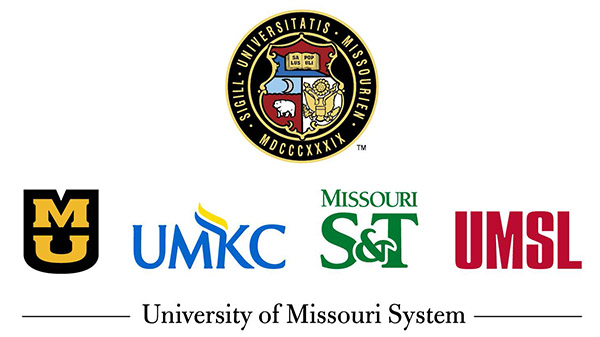Introduction
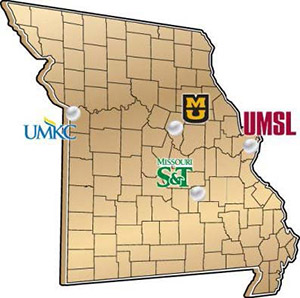 The primary purpose of the University of Missouri Extension is to serve Missouri by extending the research-based knowledge and problem-solving resources of the University of Missouri System to empower people throughout the state.
The primary purpose of the University of Missouri Extension is to serve Missouri by extending the research-based knowledge and problem-solving resources of the University of Missouri System to empower people throughout the state.
MU Extension is supported by a unique partnership of federal, state and local governments. MU Extension provides access to the university's information and educational resources most needed by the people of Missouri. County extension councils, as established by state statute, and field-based faculty are partners in the development, implementation and evaluation of educational programs. The Extension Service of the United States Department of Agriculture is also a formal partner in the cooperative extension program.
When possible, MU Extension cooperates with Lincoln University to deliver a single, coordinated cooperative extension program. Extension clientele throughout the state are youth and adults from all socioeconomic, racial and ethnic groups.
Section 1: The Vision & Mission
At the University of Missouri Extension, we are dedicated to serving as a premier educational resource that enhances the quality of life locally, nationally and globally. Our vision, mission and values guide our efforts and ensure that we remain a trusted and valued partner in educational excellence and community engagement.
Vision statement
MU Extension is a valued and trusted educational solution to improve the quality of life in Missouri, the nation and the world.
Mission statement
Our distinct land-grant mission is to improve lives, communities and economies by producing relevant, reliable and responsive educational strategies that enhance access to the resources and research of the University of Missouri.
Values statement
The University of Missouri Extension is dedicated to fostering an environment that embodies our core values. These values guide our actions and decisions, ensuring that we operate with integrity and strive for excellence in all we do. Our commitment to respect, responsibility, discovery, excellence and engagement forms the foundation of our mission and vision, helping us to improve lives, communities and economies. Below, we outline these values that are central to our work and culture:
- Respect for oneself and for others is the foundation of honor and the basis for integrity. A hallmark of our community is respect — for the process by which we seek truths and for those who engage in that process. Such respect is essential for nurturing the free and open discourse, exploration and creative expression that characterize a university. Respect results in dedication to individual, as well as collective, expressions of truth and honesty. Respect is demonstrated by a commitment to act ethically, to welcome difference and to engage in open exchange about ideas and decisions.
- Responsibility requires careful reflection on one’s moral obligations. Being responsible imposes the duty on us and our university to make decisions by acknowledging the context and considering the consequences, both intended and unintended, of any course of action. Being responsible requires us to be thoughtful stewards of resources — accountable to ourselves, each other and the publics we serve.
- Discovery is fundamental to the process of learning, which requires trust. Discovery often fractures existing world views and requires acceptance of uncertainty and ambiguity. Therefore, the university must support all its members in this lifelong process that is both challenging and rewarding. As we seek greater understanding and wisdom, we also recognize that knowledge itself has boundaries — what we know is not all that there is.
- Excellence is what we aspire to, approached through diligent effort, both individual and collective. Pursuing excellence means being satisfied with no less than the highest goals we can envision. Pursuing excellence involves being informed by regional, national and global standards as well as our personal expectations. We recognize and accept the sacrifices, risks and responsibilities involved in pursuing excellence, and so we celebrate each other’s successes. We commit ourselves to this process in an ethical and moral manner.
- Engagement is our commitment as a learning organization focused on greater access and inclusivity. This commitment comes with a responsibility to listen to and collaborate with our communities, participants and stakeholders. Engagement is demonstrated by a reciprocity and partnership where knowledge and its application are exchanged in an atmosphere of mutual respect. Engagement enriches scholarship, fosters relevant responses and enhances social and economic outcomes.

Section 2: Historical Context
For over 100 years, MU Extension has empowered people by disseminating research-based knowledge and practical experience, helping them lead more productive and satisfying lives. Originating from federal acts designed to deliver the practical benefits of education and scientific research, MU Extension is part of an educational system dedicated to enhancing human potential in a changing social and economic environment. The evolution of the Cooperative Extension Service was shaped by several key legislative acts. Each act played a crucial role in expanding educational opportunities and extending the benefits of university research to all citizens, improving economic prospects and quality of life. Below is a brief explanation of each legislative act and its impact:
- The 1862 Morrill Act established the land-grant university system, making university education and vocational skills accessible to all citizens. This uniquely American system has driven growth and change across the states it serves.
- The 1887 Hatch Act established agricultural experiment stations, enhancing the research capabilities of land-grant universities. These stations conduct research that benefits agricultural producers and ensures a safe and reliable food supply.
- The 1890 Morrill Act expanded the land-grant system to include institutions serving minority students and increased funding to ensure inclusivity regardless of race. Today, each state and U.S. territory has a land-grant university, with 17 states hosting an 1890 institution.
- The 1914 Smith-Lever Act created the Cooperative Agricultural Extension Service, a partnership among federal, state and county governments. This act allowed universities to extend their programs beyond the campus, reaching all citizens and enhancing the practical application of research and education.
“The mission of University of Missouri Extension is to address high-priority needs throughout the state by extending research-based knowledge and resources.”
Extension in Missouri has evolved significantly from its agricultural origins to cover additional areas like Community Health and Wellbeing, Youth Development, Business, and Continuing Education. Key milestones include integrating 4-H in 1927 and establishing county councils in 1955 for local input. The merging of continuing education with extension in 1960 enhanced programs such as fire training and law enforcement. A pivotal partnership with Lincoln University in 1972 further strengthened the extension system. Collaboration among federal, state and local entities ensures effective service delivery.
Originally focused solely on farming, Missouri's extension program has adapted to modern needs, offering education in diverse fields. The mission of University of Missouri Extension is to address high-priority needs throughout the state by extending research-based knowledge and resources. County extension councils, mandated by statute in 1955, guide local educational programming needs. Volunteers collaborate with extension faculty and stakeholders to secure operational funds, primarily from county governments.
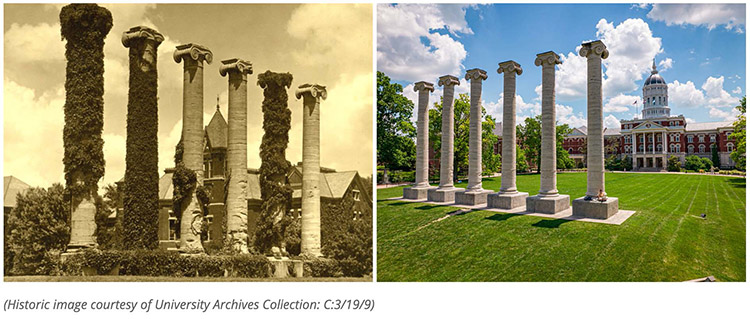
Section 3: MU Extension’s Roles, Responsibilities and Organizational Structure
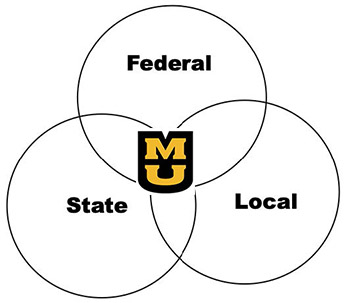 The University of Missouri (MU) Extension's success relies on multi-level collaboration among federal, state and local governments. Each level has clearly defined roles and responsibilities to ensure effective statewide delivery of educational resources.
The University of Missouri (MU) Extension's success relies on multi-level collaboration among federal, state and local governments. Each level has clearly defined roles and responsibilities to ensure effective statewide delivery of educational resources.
Roles & responsibilities of MU Extension
Federal level: National Institute of Food and Agriculture (NIFA)
- Functions:
- Identifies issues and trends influenced by extension services.
- Recommends relevant legislation and policies to Congress.
- Communicates funding needs to Congress.
- Consults on program development with state extension services.
- Evaluates program implementation and progress.
- USDA oversight:
- The USDA oversees the extension system, with program leaders and oversight committees ensuring accountability.
- The Cooperative Extension Service was established by the Smith-Lever Act of 1914, with Missouri statutes outlining current activities.
State level: Land-Grant Universities (MU Extension and Lincoln University)
- Responsibilities:
- Manage extension services under a cooperative agreement.
- Advance the land-grant system through research, teaching and extension.
- Manage funds from various sources for extension initiatives.
- Engage with USDA and federal entities.
- Provide research-based information to regional specialists.
- Employ professional staff at state and local levels.
- Oversee county extension offices and report to the state legislature.
- Structure:
- MU Extension is accountable to the UM System Board of Curators, with administrative oversight by the vice chancellor for extension and engagement.
- Lincoln University conducts complementary research with extension programs.
County level: Local collaboration
- Roles:
- Field faculty specialists create and implement tailored educational programs.
- County commissions identify local educational needs, provide funding and participate in council deliberations.
- Extension councils plan and deliver educational programs, manage finances and organize council operations.
- Partnerships:
- County governments are required by Missouri law to financially support extension programs.
- County commissions and councils ensure coordination and cooperation in delivering education tailored to local needs.
Organizational leadership chart
It is essential to recognize the collaborative framework that spans federal, state and county levels. The following organizational leadership chart outlines the hierarchy and relationships between various entities and positions within MU Extension. This chart illustrates how federal oversight by the USDA and NIFA, state level management by land-grant universities like the University of Missouri and Lincoln University, and county level coordination by local commissions and extension councils come together to deliver comprehensive educational programs. Each level's distinct yet interconnected roles ensure the effective delivery and administration of extension services across Missouri.

To see our current administrative team, visit our Leadership team pages and view our Organizational chart (PDF)
The Council & MU Extension partnership
The council and MU Extension partnership embodies a collaborative framework essential for delivering adult education across Missouri. Mutual responsibilities emphasize respect for each other’s autonomy and a shared vision of extending the mission of the “people's university.” MU Extension operates within a structured accountability framework, reporting to the UM System Board of Curators through administrative oversight by the UM System president and the vice chancellor for extension and engagement. Supported by an advisory council, this partnership facilitates effective regional and program management, with regional directors overseeing specialists and county extension centers, and program directors driving development in key areas such as agriculture, environment, health, youth development, safety, business, and emergency training.
Mutual responsibilities:
- Respect: Both partners must respect each other’s rights and avoid interference in each other's work.
- Vision: Council members should view the extension as “theirs” to achieve the vision of the “people's university.”
Organizational relationships:
- Accountability: MU Extension is accountable to the UM System Board of Curators.
- Administrative structure: The UM System president oversees MU Extension, delegating specific responsibilities to the vice chancellor for extension and engagement.
- Advisory council: Provides advice and support to the statewide extension program.
Regional and program management:
- Regional Directors: Manage eight extension regions, overseeing specialists and county extension centers.
- Program Directors: Develop programs in major areas such as agriculture, environment, health, families, youth development, safety, business, and emergency training.
University & Council agreement provisions
The University and Council agreement provisions establish the foundation for a successful partnership between MU Extension and local extension councils. These provisions delineate the specific commitments and responsibilities of both the university and the councils to ensure the effective delivery of educational programs across Missouri. The university's role focuses on providing administrative support, funding, resources and professional development, while the councils are responsible for local leadership, administration and ensuring the necessary infrastructure and support for extension employees. Collaborative partnerships further enhance this cooperative effort through cost-sharing and resource allocation for travel, youth programs and administrative support.
University provisions
- Provide funding and resources for county-based faculty and staff.
- Offer professional development, computer equipment and financial systems.
Council provisions
- Provide leadership and administration for the county extension program.
- Ensure safe office space, furnishings and utilities for extension employees.
- Offer administrative support and funding for programmatic travel.
- Utilize a uniform financial system and report annually to the university.
Collaborative partnerships
- Travel: Cost-sharing options for county program staff travel.
- Youth Program Assistants (YPAs): Counties provide physical resources while the university provides computer equipment. Both partners share salary and benefit costs.
- Administrative support: Councils may partner with the university for hiring administrative support employees, with the university handling benefits and tax paperwork.
Section 4: Duties & Legal Aspects
An ideal University of Missouri Extension Council and its members embody a range of essential qualities and responsibilities that ensure the effective oversight and implementation of MU Extension activities at the county level, fostering a strong connection between the council and the community it serves.
 What would an ideal University of Missouri Extension council member look like?
What would an ideal University of Missouri Extension council member look like?
The University of Missouri Extension Council is the legally responsible body that oversees and implements all MU Extension activities at the county level. To be effective and impactful, council members should embody several key characteristics:
- Vision: An ideal council member should have the foresight to envision a successful future for their community. They should understand the long-term implications of decisions and act in the best interest of county citizens.
- Knowledge: They should be well-versed in the needs of the county and its citizens, and familiar with the organizations and entities that operate within the county. Specialized knowledge or skills, such as expertise in marketing, law or other relevant fields, would significantly enhance MU Extension’s programming efforts.
- Open-mindedness: A council member should demonstrate the ability to carefully consider ideas and options, weighing them thoughtfully before reaching a conclusion.
- Decisiveness: They should be able to make informed decisions and articulate the rationale behind those decisions, while remaining uninfluenced by internal opinions or factions.
- Enthusiasm: An ideal council member is genuinely passionate about the council’s goals and actively communicates this enthusiasm to others, both within and outside the organization.
- Participation: Active participation is essential. Ideal members regularly attend council meetings, thoroughly review financial documents and other reports beforehand, and engage fully in discussions and votes during meetings.
What would an ideal University of Missouri Extension Council look like?
A group of ideal council members would collectively form an extension council that:
- Has a clear purpose: The council operates with a well-defined mission, ensuring all actions and decisions align with its core objectives.
- Develops responsible leadership: Effective leaders (officers) are cultivated within the council, guiding its deliberations and ensuring productive outcomes.
- Partners with local faculty and engagement specialists: The council collaborates closely with local faculty and engagement specialists, fostering a strong partnership to enhance community impact.
- Prioritizes and plans carefully: The council strategically prioritizes tasks and meticulously plans its work to achieve meaningful results.
- Complies with Missouri statutes: All council activities and decisions adhere strictly to Missouri laws and regulations.
- Evaluates itself regularly: The council consistently engages in self-evaluation to identify areas for improvement and ensure continuous effectiveness.
- Provides a positive experience: Members find their involvement both enjoyable and rewarding, contributing to a productive council environment.
- Reflects county diversity: The council represents the diverse backgrounds, perspectives and needs of the county’s citizens, ensuring inclusive and equitable decision-making.
Duties of the council
There are several duties of council members set forth in Missouri’s Revised Statutes, but they can be organized into four main categories. Each primary responsibility set forth in Missouri’s Revised Statutes also has several procedural or practical responsibilities which may be governed by a provision within a council’s bylaws or by policies or procedures established by the council, University of Missouri Extension, or the University of Missouri System. Councils may seek an opinion from an attorney representing the council. Copies of Missouri’s Revised Statutes are available at the county extension office.
 1. Programming
1. Programming
Councils assist MU faculty and staff in determining programming needs within the county.
- Approval and oversight: The council is responsible for approving the assignment of MU Extension specialists headquartered in the county and can make recommendations regarding personnel changes. Additionally, the council hires and often supervises support staff to ensure the effective operation of the county office.
- Engagement with educational opportunities: Council members should stay informed about educational opportunities scheduled within their county. Whenever possible, they should attend these programs to gain a deeper understanding of their value and impact.
- Promotion and advocacy: To maximize the reach of these programs, council members should actively promote educational opportunities by informing fellow citizens of their availability.
- Community feedback: Council members should make a concerted effort to learn about the educational needs and concerns of county residents and communicate these insights to the council, MU faculty and staff.
MU Extension is dedicated to improving the lives of Missourians by addressing the following four Grand Challenges through its programming:
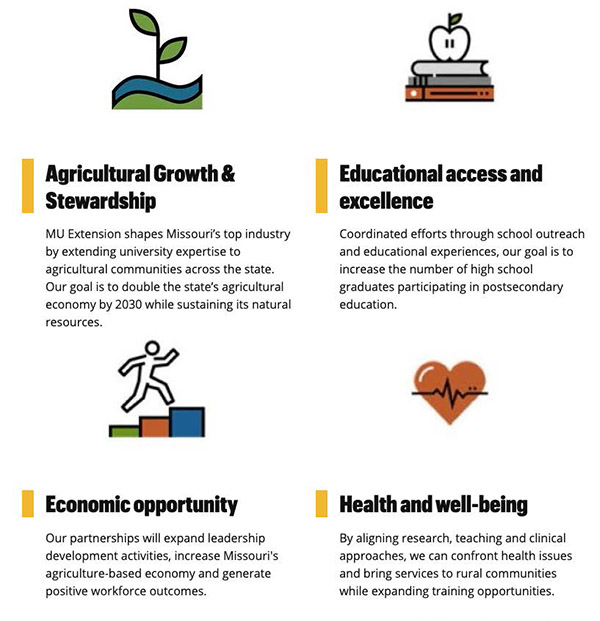
2. Governance
Extension councils are directly responsible for overseeing the operations of local extension offices.
- Staff management: The council hires and supervises support staff to ensure the smooth and effective operation of the county office (see Section 7).
- Financial oversight: Councils manage the finances of the local extension operations, developing a budget in collaboration with the county commission to secure necessary funding for the county office and educational programs. The council is also responsible for paying the salaries of support staff and covering the operational expenses of the county office (see Sections 5 and 6).
- Fundraising and revenue management: The council oversees the collection of fees for specific programs and activities, conducts private fundraising efforts, and requisitions monthly appropriations from the county commission.
- Annual reporting: At the close of each calendar year, the council, through its secretary, must submit a detailed annual report to the county commission or court. This report should include a comprehensive summary of all receipts, expenditures and the results of the work undertaken. The prior year’s report must be filed by February 1. This annual report can also serve as an effective marketing and public relations tool, highlighting how extension programs have positively impacted the lives of county citizens.
- Civil rights compliance: Councils must ensure that all activities comply with civil rights requirements. This includes assessing and making progress in providing educational opportunities for individuals with accessibility needs, aging adults, low-income citizens, non-English speakers and other groups. Councils should regularly discuss strategies for reaching unserved or underserved audiences, and the county office must maintain all records necessary to comply with federal civil rights compliance requirements.
- Meeting requirements: Councils are required to hold an annual meeting, during which they must elect, at a minimum, a chairman, vice chairman, secretary and treasurer. Councils must meet at least bimonthly, with officers required to meet monthly, even if the full council does not convene that month.
- Missouri Sunshine Law compliance:
 Councils must adhere to the Missouri Sunshine Law, which includes the following key requirements:
Councils must adhere to the Missouri Sunshine Law, which includes the following key requirements:
- Notice of Meeting (610.020 RSMo.): Notice must be posted 24 hours in advance at the extension office or the meeting location. The notice should include the time, date, location, a tentative agenda and whether the meeting is open or closed to the public.
- Closed Meetings (610.021 RSMo.): Closed meetings are permitted only under specific exceptions outlined in the statute. To enter or exit a closed meeting, a roll-call vote must be taken, with a majority of council members present voting to close or reopen the meeting. No other business may be discussed except what is authorized under 610.021 RSMo.
- Public Records (610.023 RSMo.): Records of an extension council are to be open and available to the public for copying unless otherwise restricted by law. Requests for records must be addressed no later than the end of the third business day following the custodian’s receipt of the request. If access cannot be granted within that time frame, a written explanation must be provided. A reasonable fee, not exceeding the actual cost, may be charged for copies pursuant to the Missouri Sunshine Law (610.026 RSMo.).
 3. Membership
3. Membership
The council should strive to be a true reflection of the citizens of the county. To achieve this, a public election to elect new council members must be held each January, as outlined in 262.573 RSMo.
- Election planning: The council is responsible for setting the time, date and location of the election. Councils have the authority to determine the number of elected positions for each district, ensuring that no district is underrepresented. Each district must have at least one council member, with the total number of elected council members ranging between ten and twenty.
- Candidate nomination: The council should propose at least two candidates for each open position on the council. In addition, the council must solicit appointments from farm organizations and eligible municipalities, as required by 262.583 RSMo.
- Additional nominations: Additional candidates may be nominated through a petition signed by twenty-five or more qualified voters residing within the district, as specified in 262.577 RSMo.
- Election procedures: The council is responsible for publishing a notice of the election and certifying the election results to the county clerk.
4. Relationships with Extension Engagement Specialist (EES) and faculty specialists
The local extension council acts as a vital link between the community and the University of Missouri Extension. In collaboration with the Extension Engagement Specialist (EES), the council will:
- Fulfill their statutory responsibilities.
- Share oversight of office staff, ensuring the implementation of best practices in operations, finance and human resources, including standard and ad hoc reporting as required.
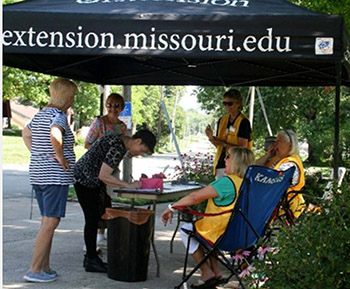 Engage with communities, stakeholders, elected officials, agencies, partners and professional organizations to foster collaboration and support for extension programs.
Engage with communities, stakeholders, elected officials, agencies, partners and professional organizations to foster collaboration and support for extension programs.- Conduct annual performance reviews of the office assistant.
- Connect with county commissions and legislators to strengthen their understanding of the value and impact of University of Missouri Extension programs.
- Assist field specialists in building relationships with stakeholders and partners to expand programming opportunities and increase community impact.
- Work closely with extension faculty and staff to ensure appropriate and relevant programming is delivered to each county.
5. Additional resources
For additional information and guidance, councils can reference resources related to elections, financial reviews, personnel, budgets, Sunshine law and more on the County Councils webpage.
Section 5: County Fiscal Management
Funding for Extension programs is shared among the following entities:
- The U.S. Department of Agriculture (USDA)
- The University of Missouri
- County extension councils
The USDA and the universities provide funding for salaries and benefits of extension specialists, training costs, administrative expenses and special program support. County extension councils are responsible for funding local offices and operations, program expenses and council-related expenses.
 Planning a budget for county funds is straightforward, yet each step is crucial to achieving the overall goal.
Planning a budget for county funds is straightforward, yet each step is crucial to achieving the overall goal.
- Set goals
- Estimate income
- Estimate expenses
- Evaluate
Budget committee
The extension council and staff should collaborate in the goal-setting process through informal group discussions and joint meetings. Important considerations include:
- Program planning: What programs are planned for the county, and what support is needed to ensure their success (e.g., printing, office equipment, travel, supplies, advertising, additional office support or 4-H Youth Program Associates’ salaries)?
- Short-term goals: Examples include purchasing new equipment, making replacements or upgrades and increasing specific category funds.
- Long-term goals: Examples include office relocation or remodeling, adding specialist positions and enhancing technology.
Program-specific budgets should also outline budget needs for the next fiscal year. As specialists or council members recommend county programs, they should consider the associated costs, the potential for cost recovery through fees and the resources required to support the programs.
Sources of funding
Councils rely heavily on county commission appropriations as a primary funding source. Additional funding sources include:
- City appropriations
- Program participant fees
- Investment income
- Gifts from individuals or local charities (e.g., United Way)
- Various grants, contracts and collaborations
Over time, county offices have faced increasing challenges in maintaining stable local financial support and have turned to seeking additional “soft” funding sources, such as one-time contributions to the local budget. Examples of soft funds include program participant fees and grants.
Extension staff play a key role in assessing the viability of fees, grants and contracts, and in finding local partners to share program costs. Office support staff, engagement specialists and council treasurers are crucial in maintaining council records. All extension council members can contact granting and allocating agencies, such as the county commission, city council, United Way and other civic or charitable organizations. They can also identify partners with similar organizational goals to share program expenses.
Dividing expenses
- USDA and university funds cover the following:
- Salaries and benefits of extension specialists and some education assistants
- Training for extension specialists
- Travel to state training and committee meetings
- Regional and statewide administration
- Some computer equipment costs
- All computer maintenance costs
- County appropriation funds cover:
- Physical space for the extension office
- Salaries and benefits (if available) for office support staff
- A percentage of some program associates' salaries and benefits
- Travel within the region
- Office furniture and equipment
- Phone service
- Office supplies, postage and printing
- A portion of computer costs (e.g., Adobe, QuickBooks online)
- Insurance for office contents
- Council maintenance costs (e.g., elections, audits, surety bond insurance, Directors and Operators insurance, Workers' Compensation insurance)
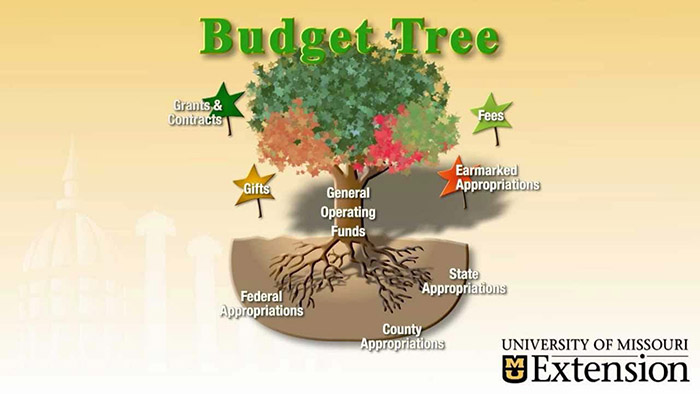
Estimating expenses
While historical data is commonly used to estimate expenses, it should not be the sole method for setting new goals. Extension council and MU Extension budgets typically have a high proportion of fixed expenses, which poses a challenge when implementing a final budget with limited flexibility.
Extension faculty and staff should estimate program expenses, while office support staff and Extension Engagement Specialists should use records to estimate other expenses and obtain bids as necessary to ensure the best and lowest-cost goods or services. Extension council members can assist by understanding the impact of the budget on the council program and suggesting vendors or cost-saving measures.
Evaluate & revise
 A council has the same options as a family when creating a budget:
A council has the same options as a family when creating a budget:
- Look for ways to increase income
- Eliminate expenses
- Reduce expense categories
There is no single correct answer, so it’s important to think creatively when exploring alternatives to balance the budget. The budget committee should carefully consider the impact of any reductions, weighing short- and long-term implications as they finalize the budget.
Approval & timeline
- Class 1 counties: Must submit their budget to the commission by September 1.
- All other counties: Must prepare a budget to present to the commission in December.
Budget committees should begin meeting in July (for Class 1 counties) and September (for other counties) to allow time for discussion within the committee, presentation to the full council for review and adjustment, and final approval for submission to county commissioners. The committee should present the current year’s budget (both proposed and actual), the proposed budget for the next year and a discussion of alternatives reviewed by the budget committee. The full council is responsible for determining the final budget to present to the county commission.
County councils are strongly encouraged to attend budget proposal meetings with county commissioners, alongside Extension Engagement Specialists, field specialists and any other county staff, to show support for extension and answer questions related to the proposed budget.
Section 6: Financial Review
As a best practice, councils should conduct an annual review of their financial reports. At a minimum, councils should internally review their fiscal records and operating procedures each year. Additionally, when a new treasurer assumes office, a financial review or external audit is recommended to safeguard both the council and the incoming treasurer.
Councils have several options for conducting financial reviews:
- External audit: Engage a certified accountant or audit firm to perform a formal audit. The firm will follow its own established audit process.
- External financial review: Opt for a less formal external review by following the Financial Review Guidelines for county extension councils.
- Internal financial review: Appoint a council financial review committee to perform an internal review. This is the least formal option and should follow Financial Review Guidelines for county extension councils. The committee must include at least three members, one of whom should have bookkeeping experience. It is advisable that committee members do not have signature authority.
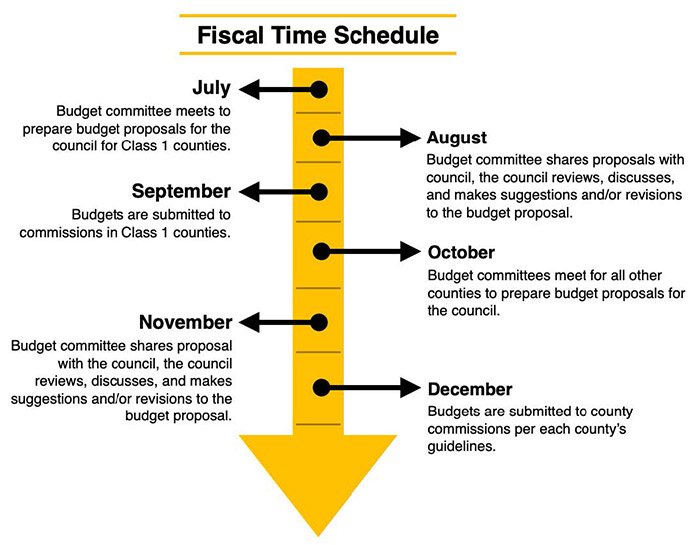
Getting started
- Entrance conference:
Arrange an initial conference with the council bookkeeper and the county extension engagement specialist to discuss the review’s scope and identify the necessary materials. - Information & materials needed:
- QuickBooks for county bookkeepers
- Regular/monthly financial status reports
- Checkbook: check stubs or check register receipt books, bank statements (checking, savings, investments)
- Extension Council Best Practice for Fiscal Management (PDF)
- Vacation and sick leave records for council-paid personnel
- Bank reconciliation reports: lists of outstanding checks, deposits, verified checks and verified deposits
- A list of all transactions for the year
- A detailed ledger report for the year – monthly detailed ledger reports also should be on file
- A list of accounts receivables and accounts payables
- Budget overview versus actual report, which shows year-to-date income and expenses compared with budget allocations
- Savings and investments reports
- Annual financial report and balance sheet
- An inventory report
- Interviews:
It is appropriate to interview any staff or council members who collect funds (fees, contributions); make or correct accounting entries; make deposits; receive, open and/or reconcile bank statements; and prepare fiscal reports. - Suggested interview questions:
- What information and/or training have you been provided concerning fiscal policies and procedures? Is training adequate?
- Bookkeepers: What training have you been provided regarding the accounting system?
- Who is responsible for receiving cash?
- Is a receipt written for each item or amount of income received?
- Are checks received endorsed with a restrictive “for deposit only” stamp when received?
- How often are deposits made? Who makes deposits?
- How are cash and checks secured during working hours and when office is closed?
- Are any payments made by means other than by check? If so, for what and by whom?
- Is a petty cash fund maintained? If so, how are disbursements and reconciliation handled?
- Do you have suggestions for improvements?
- Verifying records & procedures:
 Select one month's financial records, and secure the complete fiscal file for that month. Randomly select 15-20 types of fiscal transactions from other months throughout the year. Review all transactions for the selected month and the other randomly selected transactions as follows:
Select one month's financial records, and secure the complete fiscal file for that month. Randomly select 15-20 types of fiscal transactions from other months throughout the year. Review all transactions for the selected month and the other randomly selected transactions as follows:
- Review council minutes for authorizations of payments, purchases and other fiscal transactions.
- Review procedures, documentation and authorization process for any payments or purchases in excess of $500.
- Match canceled checks with actual expense transactions.
- Match deposit slips with actual deposit/receipt transactions.
- Verify that deposit receipts indicate that deposits are made at least weekly.
- Match accounting system checkbook balance with bank reconciliation of checking account.
- Match investment report balance with bank reconciliation of savings account.
- Verify that cash and checks are kept in a secured location.
- Verify that petty cash funds, if any, are reconciled at least monthly.
- Verify that checks on hand are stamped “for deposit only.”
- Review all documentation related to entry corrections in the accounting system.
- Verify that voided checks are accounted for.
- Verify that checks and receipts are consecutively numbered.
- Review documentation for all deposits and checks written.
- Review time sheets for signatures by individual and supervisor. Compare time sheets with payroll records for actual hours paid.
- Verify payment of payroll withholdings to state and IRS.
- Review vacation and sick leave records for currency and timely entries.
- Review record of accounts receivables and accounts payables.
- If monthly fiscal reports were prepared other than those provided by the accounting system, verify the amounts on such reports with accounting system information.
- Physically verify several items of equipment listed on the inventory report.
- Verify currency of the inventory report for entries of recently secured items.
- Exit conference:
Before the close of the financial review and completion of the final report, meet with the Extension Engagement Specialist, bookkeeper and others as appropriate to determine if clarifications are needed before preparing the final report. - Report to the council:
A written report is presented by a financial review committee representative at a regular council meeting and made a part of the minutes. The financial review report should be available to the public and county commission, and a copy provided to the regional director and to MU Extension (through the regional director). - Recommended report outline:
- Identify members of the financial review committee.
- Date(s) within which the committee's work was completed.
- Identify staff, council members and others who were interviewed and/or provided assistance in collecting, reviewing and interpreting information.
- Report findings from interviews, observations and review of information.
- State any findings and/or recommendations, including corrective actions, changes in policies or procedures, and improvements in practices.
- Council action:
If the report includes recommendations, the council should identify the staff or council members responsible for implementing those actions, set a timeframe for completion, and establish a timeline for the responsible parties to report back on the actions taken.
“At a minimum, councils should internally review their fiscal records and operating procedures each year. Additionally, when a new treasurer assumes office, a financial review or external audit is recommended to safeguard both the council and the incoming treasurer.”
Section 7: Personnel
According to Missouri Statutes 262.560 and 262.587, the University of Missouri shall:
- “Have responsibility and authority to employ and discharge personnel as it deems necessary and proper for the conduct of extension work within the county and shall prescribe and assign their duties.”
Before assigning any extension personnel in the county, the university should consult and advise with the council affected. If personnel proposed by the university is not satisfactory to the council, the council is not required to agree to house the person. This does not guarantee an alternative choice will be available. The council should also be consulted in as much as is allowed by law before taking action to discharge or remove any employee.The council shall (statutes 262.587, 262.590):
- Make recommendations and suggestions to the university concerning the appointment or removal of extension personnel. Approve the assignment of personnel headquartered in their county.
- Be consulted by the university prior to removal or discharge of personnel.
Councils also have the responsibility to employ local office support or temporary positions that help to achieve the extension mission. If councils choose to handle this responsibility on their own, they are bound by the same Equal Employment Opportunity programs as any employer.
Councils may choose to hire their local employee through the university. In this case, the university maintains the legal supervision, payroll and benefits in partnership with the council who pays the payroll through the university.
The council consults the Extension Engagement Specialist when opening and advertising a position and conducting interviews. The employee is still managed in partnership with the council.
Equal access
Equal Employment Opportunity programs are legal concepts and obligations defined in applicable laws, rules, regulations and policies implementing those provisions. Copies of these applicable laws, rules and regulations are maintained in the county civil rights file and are available for public inspection and include the following resources:
- Title VII of the Civil Rights Act of 1964
- Title IX of the Education Amendments of 1972
- Section 503 of the Rehabilitation Act of 1973
- Age Discrimination in Employment Act of 1967
- Vietnam Era Veterans Readjustment Act of 1974
- Equal Pay Act of 1963
- Civil Rights Act of 1966
- Executive Order 11246, as amended
- The Americans with Disabilities Act (ADA) of July 1990
As recipients of federal, state and local public funds, MU Extension is required to ensure individuals have equal access to employment opportunities and equal access to participation in extension programs without unlawful discrimination on the basis of race, color, national origin, ancestry, religion, sex, pregnancy, sexual orientation, gender identity, gender expression, age, disability, protected veteran status or any other status protected by applicable state or federal law.
Compliance with federal civil rights laws, regulations and other guidance requires extension to encourage program participation of unserved and underserved groups with the goal of achieving parity of representation in all extension programs; to recruit, employ and promote qualified members of formerly excluded groups; and to ensure nondiscrimination in all terms and conditions of employment, including work assignments, educational and training opportunities, use of facilities, and opportunities to serve on committees and decision-making bodies.
Any student, employee, volunteer, visitor or patient who believes that the University of Missouri, one of the campuses within the University of Missouri System, or one of the educational programs, departments or other institutional entities has violated the Sex Discrimination, Sexual Harassment and Sexual Misconduct in Employment/Education Policy should report the Complaint to the Title IX Coordinator:
- MU Office of Institutional Equity
Phone: 573-882-3880
Email: equity@missouri.edu
Contact information is also available within each county extension center.
Inclusive excellence
MU Extension will create, advance and embody a culture of inclusivity within each person, system and practice. Emphasis on access and inclusive engagement that supports equal employment opportunity and civil rights compliance that goes beyond basic compliance with statutory and regulatory obligations. With changes in the workforce, populations and ever-changing community needs, MU Extension must strive to create a more diverse and inclusive approach to its work.
To meet its mission of inclusive excellence, MU Extension and partners must be intentional in efforts to go further than basic compliance with the law. MU Extension should strive to develop and maintain a diverse and inclusive faculty and staff and adjust operations and programming to work more effectively and make a difference in issues important to residents of the counties and communities served. By maintaining emphasis on civil rights compliance and inclusive excellence, MU Extension will continue to be effective, productive and relevant now and in the future. Effective and successful extension education and programming, to “Serve Missouri and Deliver Mizzou,” means outreach and engagement with all Missourians from all cultural groups and underserved populations in the state.
Section 8: Memorandum of Understanding (MOU)
MU Extension Program Directors oversee the development and management of programs in key areas such as agriculture and environment, health and families, 4-H youth development, health and safety, business and communities and emergency rescue training. They collaborate with regional directors, campus deans and field specialists to create and implement these programs.
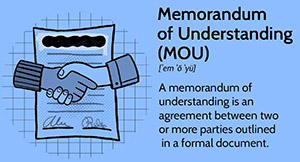 MU Extension and the county extension council work together to deliver the land-grant mission of providing high-quality education, applying research to the needs of Missouri and extending knowledge to the state's citizens. Their partnership is formalized in a Memorandum of Understanding (MOU), which is reviewed and signed annually.
MU Extension and the county extension council work together to deliver the land-grant mission of providing high-quality education, applying research to the needs of Missouri and extending knowledge to the state's citizens. Their partnership is formalized in a Memorandum of Understanding (MOU), which is reviewed and signed annually.
The University agrees:
As part of the agreement, the University of Missouri commits to:
- Providing programmatic faculty or staff based on local support and programmatic needs.
- Supporting county-based university faculty and staff with internet connectivity, travel system infrastructure, professional development and necessary computer equipment.
- Offering financial and accounting system support for each county.
The above represents an average investment per county in local Extension programming and operations of $154,000 by the University of Missouri.
The Council agrees:

In return, the county extension council agrees to:
- Provide leadership and administration for the county extension program per Missouri law (Revised Statutes of Missouri, Section 262.550 to 262.620).
- Ensure safe and appropriate office space, furnishings and utilities for council and MU Extension employees.
- Offer administrative support for the council, office operations and university extension programming.
- Fund programmatic travel within the county.
- Utilize a uniform financial and accounting system and report annually to the university.
Optional partnership collaborations:
Through the MOU, the council and university may also collaborate on the following:
- Travel system: The university manages a statewide travel system for regional faculty and program staff, with a 30:70 cost-sharing ratio. Counties participating in this program will be informed of their budget amount by December 1 for the next calendar year.
- Youth Program Assistant/Associate/Educator: The council supports 50% of the salary and benefits for a Youth Program Assistant (YPA), with the university covering the remaining 50% and providing necessary equipment.
- Administrative support: The council may partner with the university to hire administrative support as a university employee, covering 100% of the salary, while the university handles evaluations, benefits and tax-related paperwork.
Section 9: Elections & Membership
One of the key responsibilities of the county extension council is recruiting candidates for council membership and ensuring elections comply with state statutes. Missouri State Statute 262.567 RSMo dictates the council's composition, requiring a minimum of 10 and a maximum of 20 elected members.
Council members serve two-year terms and may be re-elected for a second term. Any vacancies can be filled by council appointment until the next election. The council also includes appointed members, such as:
- A representative from the county commission
- A representative from each general farm organization with 25 or more members (e.g., MFA Inc., Farm Bureau, National Farmers Organization)
- A representative from each incorporated town/city with a population of 10,000 or more
- A representative appointed by the mayor for towns/cities with less than 10,000 population, as designated by the county extension council
Recruitment
Extension Engagement Specialists should continuously discuss council membership to ensure diverse representation across the county. Councils should periodically engage in a process of barrier analysis to identify obstacles to participation by individuals from unserved and underserved groups in their county and take appropriate steps to mitigate and eliminate such barriers. Councils may not discriminate on the basis of race, color, national origin, ancestry, religion, sex, pregnancy, sexual orientation, gender identity, gender expression, age, disability, protected veteran status or any other status protected by applicable state or federal law in recruitment efforts. By September 1, the council and faculty should begin preparing for the upcoming election, ideally forming an election committee to manage recruitment.
Who is needed?
Council members should reflect the county's diversity in perspectives and experiences. Candidates should represent various age groups, races, ethnicities, genders, veteran statuses, abilities, socioeconomic backgrounds, locations and career fields.
Who will serve?
When identifying candidates, avoid making assumptions about their willingness to serve. If someone is a good fit, they should be encouraged to join the council.
Conducting elections
- Set election dates (November): The council should set the election date, typically held in the second or third week of January.
- Voting methods (November): Councils should consult Missouri State Statutes and their county clerk to determine the most accessible voting methods. Options include online voting, in-person voting with paper ballots, ballots published in local media, or mailed ballots.
Legal notice for elections
- Legal notice (December): A paid legal notice listing the nominees must be published in a public news media outlet “not more than 50 days or less than 30 days” before the election. The notice should also state that additional nominations can be made by petition, signed by 25 or more qualified voters, within 20 days of the notice's publication. In some counties, the notice may need to be published in more than one outlet for adequate coverage.
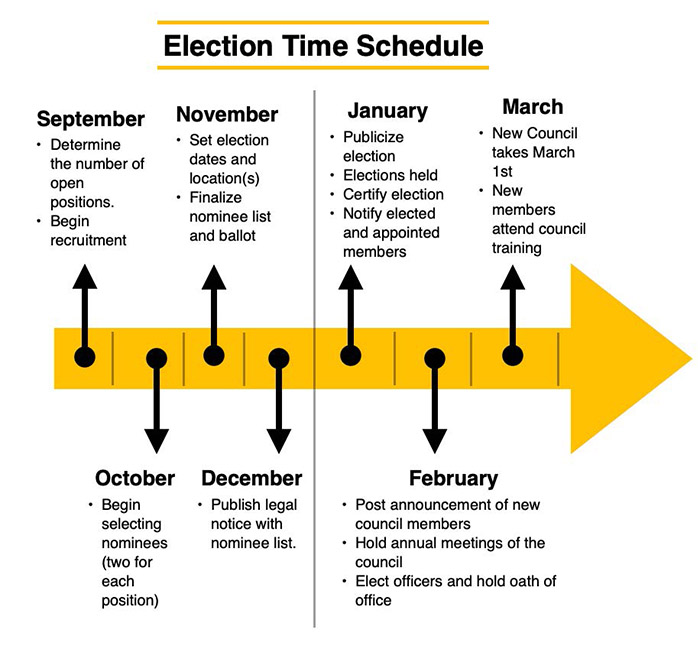
After the election
- Certify the election (January): At least three council members should count paper ballots and enter the results to the MU Extension Council web application and certify the election. The results of all ballots should be reported to the county clerk and the university.
- Notify elected and appointed members (January): Immediately after the election, notify all nominees of their election or appointment. Invite new members to the next council meeting or annual meeting, providing details on how they will be sworn into office.
The newly organized extension council begins its duties on March 1st of each year.
Annual meeting (February)
The annual meeting is typically held in February. The county clerk should be invited to administer the oath of office to newly elected officers. During this meeting, the council should elect a chairperson, vice-chairperson, secretary and treasurer who will take and sign an oath of public office within five days.
New member orientation
As soon as a new member is elected, they should be formally introduced to the council. The Extension Engagement Specialist will conduct an orientation in March for both new and continuing members.
Each new member should receive a packet containing:
- UM Extension County Council Best Practices Guide
- County council manual
- County annual report and budget
- List of current council members and contact information
- Organizational chart for the county, including faculty and staff
- Schedule of council meetings for the year
- Minutes from the previous meeting
Council leadership training
Regional directors and engagement specialists may provide leadership training for council members. This training can be a single-day event or conducted over several sessions outside regular meetings. Ask your regional director or extension engagement specialist for upcoming training opportunities.
Section 10: The Agenda
The agenda for MU Extension Council meetings should be the culmination of input from both council members and extension faculty and staff. Approximately two weeks before the meeting, the council chair and Extension Engagement Specialist (EES) should collaborate to develop the agenda. In some offices, this planning session may also include the office assistant.
Effective meetings
Effective and well-organized meetings are crucial for ensuring that all necessary business matters are addressed within the monthly or bi-monthly intervals between meetings. To facilitate this, it’s important to follow a structured agenda that aligns with the basic principles of Robert's Rules of Order, which MU Extension adheres to for orderly and democratic meeting procedures.
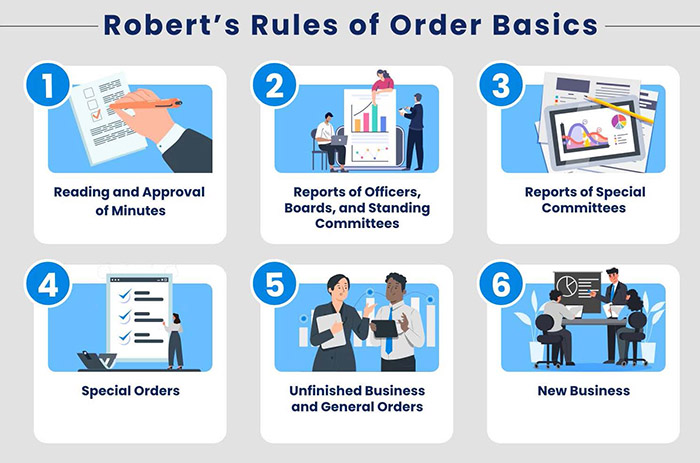
The following standard items should typically be included in the agenda for routine extension council meetings:
- Call to order: The council chair should promptly call the meeting to order. Starting on time demonstrates respect for all attendees and sets a professional tone for the meeting.
- Attendance: Record attendance, noting who is present and who is absent. This is crucial for ensuring a quorum is present to conduct official business.
- Visitor recognition: Acknowledge any visitors, as council meetings are typically open to the public. Introduce those who may contribute to the meeting, such as staff, vendors, reporters or citizens. It’s important for the council to know who is present and who may be involved in the discussion.
- Agenda approval: While the agenda is prepared by council officers beforehand, any council member can request to add items. Such requests should be made well in advance of the meeting.
- Approval of previous meeting minutes: Minutes are the official record of council actions and should be reviewed carefully. If there are any errors, they should be corrected before approval. To expedite this process, minutes are often sent out via mail or email with the meeting notice, allowing members to review them beforehand.
- Key points for minutes:
- They should be concise and focus on recording official actions, not the discussions leading up to decisions.
- Include the date, time and place of the meeting; names of attendees; exact wording of motions, outcomes, roll call votes (if applicable); and the time of adjournment.
- Key points for minutes:
- Reports
- Financial report
- This should include a Balance Sheet, Funds Class Balance, Checks Summary, Deposit Summary, and Budget vs. Actual. The EES should preview upcoming expenses or revenues. The council may authorize recurring payments annually or handle one-time expenses monthly.
- The treasurer should review all bills before signing checks, and the EES should be prepared to answer any related questions.
- Committee reports
- Standing or ad hoc committees should regularly report their activities to the council. Avoid reports from inactive committees unless there’s specific business. For efficiency, committee chairs should send written reports before the meeting, with the meeting time reserved for questions and clarifications.
- Faculty and staff reports
- These reports are for informational purposes only, helping the council stay informed about ongoing extension programs in the county. Any items requiring council action should be reserved for the "New business" section.
- Financial report
- Unfinished (old) business: Address any items carried over from previous meetings, such as tabled motions or topics adjourned before resolution. Avoid using this section as a catchall for all past discussions.
- New business: Items under "New business" typically require a motion and a vote. The chair should request a motion for each item, followed by focused discussion. If an item doesn’t receive a motion and second, the council should move on. Issues like long-range planning might be better suited for special meetings to ensure sufficient time and attention.
- Announcements: Use this time for informational purposes only, such as announcing future meetings or activities. No action is required.
- Adjournment: A motion, second and majority vote are required to adjourn the meeting. The chair should not unilaterally declare adjournment; the council collectively decides when business is complete, even if all agenda items aren’t covered.
Meeting duration
- Meetings should not exceed two hours, as longer meetings often lead to dissatisfaction, reduced productivity and poor decision-making. Periodically evaluate and adjust your meetings throughout the year to improve efficiency and effectiveness.
Section 11: Committees
Committees broaden the participation of council members and provide opportunities for more in-depth learning about the extension council. Committee activity provides interest and engagement for council members and potential for training of new members in specific areas.
When to use committees
Committees can be used most effectively when one or more of the following circumstances exist:
- A variety of information is needed to reach a decision.
- Informed volunteer workers can be effective in putting plans into action.
- Coordination in planning is needed.
- The council officers cannot and/or should not make the decision.
- Sufficient time is available to use a committee fully.
Other circumstances can be considered:
- How productive are extension council committees?
- Are many made up of the same people?
- Have projects failed for lack of proper study?
- Have programs been dropped for lack of needed resources?
- Is it difficult to get people to serve on committees?
Committees are either standing or temporary. Standing committees work on a project throughout the year and often are re-formed each year for several years. Temporary committees may develop around a specific project and then are dissolved afterwards.
Forming committees
- Committee size: The committee’s purpose generally determines committee size. In carrying out many council functions, small committees have advantages. The larger committee may be harder to coordinate; however, there are times when a larger committee is required for the task at hand. On occasion, the entire council may serve as a committee – for example, when providing feedback on or determining the program of work.
- Recruitment: Often councils may ask every member to self-identify what committees they would prefer to serve on for the year. Some considerations on filling committee roles include personal interest or expertise, and continuity in committee membership. Additionally, a description of the duties of the committees can be helpful in determining a request for service, as well as expected time commitment (frequency of meetings, etc.).
- Evaluation: Committee effort and effectiveness can be evaluated jointly by the chair and the committee. The number and types of committees should be evaluated periodically to determine whether the same committees are needed year after year.
- Orientation: One way to set a committee up for success is orientation. A council chair may provide to each committee chair:
- List of committee members, their email and telephone numbers.
- Any background material on the committee’s previous work.
- A list of last year’s committee members.
- Clear expectations or duties for the next year.
Effective committee meetings
- Preparation: Know the task at hand. If there is research to be done about the issue ahead of time, this information can be collected by the council chair, committee chair and staff. Arrange for when and where the committee will meet.
- Notes or minutes: Keeping a record of a meeting, especially one that will result in a recommendation to be made to the council or may need more than one meeting, is important if there are any follow up questions or actions. These notes are subject to Sunshine Law just like normal meeting minutes.
- Report/recommendation: Committees should prepare a verbal or written report to offer the entire council that can be recorded. This helps ensure follow through and continuity.
Common Extension Council committees
1. Elections/Nominations Committee
This committee’s work may be carried out by a specific group, but recruiting new council members is the work of all and can occur year-round.
- Time period:
- August/September (all year): Recruit new council members
- October/November: Publish public request for candidates
- December: Legal notice published 30 days before election
- January: Hold elections, count ballots, report results
- February: Nominate officers, elect officers at annual meeting
- March: New council year begins
The roles for those associated with the elections/nominations committee are as follows:
- Extension Engagement Specialist: Work with office support to prepare documents showing districts, current council members and their terms, vacancies and potential nominees. Work with office support to prepare ballots and any informational materials; publish press releases and legal notices; notify candidates of election results; contact county officials for swearing in.
- Committee members: Recruit potential new council members and submit their names and contact information to staff; count and verify ballots; nominate officers.
2. Facilities & Grounds Committee
Maintenance of office space and equipment, whether provided by the county or council-owned.
3. Financial Committee(s)
Some counties may separate fiscal work into a Budget Committee, an Audit Committee and/or an Endowment and Gifts Committee. For some councils it may be more efficient to have one Financial Committee that can oversee any fiscal stewardship projects and make recommendations to the council for action.
Annual activities of a financial committee can include:
- Developing the county budget request.
- Carrying out an annual financial records review.
- Researching current investment rates or practices for council funds.
- Studying and making recommendations on large purchases.
The roles for those associated with the financial committee are as follows:
- Extension Engagement Specialist: Work with office support to prepare documents showing average expenditures and communicate with extension administration about budget needs.
- Committee members: Review financial records and consider needs for upcoming year; report to council on proposed budget for approval; participate in formal budget presentation and/or hearing with commissioners.
4. Personnel Committee
The activity of the personnel committee will depend on personnel changes in the county. As staff vacancies occur, the committee may be responsible for the following:
- Advertising positions, coordinating interviews and making recommendations for hire.
- When not actively filling a position, this committee should also work to carry out annual performance reviews of council employees and make updates to any personnel manuals or policy documents.
- Annual performance reviews should occur before the end of a fiscal year (end of June) to consider possible pay raises in a timely fashion.
- Please refer to Section 7 for more descriptive language on personnel practices.
The roles for those associated with the personnel committee are as follows:
- Extension Engagement Specialist: Work with campus and council to develop position descriptions and coordinate hiring practices; can help committee prepare documents for performance reviews; can provide best practice guidance on policy documents.
- Committee Members: Advertise vacancies and make recommendations for hire; complete annual performance reviews for council employees.
5. Various other committees
- Special Events Committee: Plan and implement special events, including the annual meeting, dinners, fall festivals, summer picnics or ice cream socials, etc.
- Recognition Committee: Nominate candidates for State Fair Farm Family or other annual recognition programs.
- Public Relations/Marketing Committee: Can develop and implement a public relations plan, coordinate advertisement of programs, etc.
“Committees broaden the participation of council members and provide opportunities for more in-depth learning about the extension council. Committee activity provides interest and engagement for council members and potential for training of new members in specific areas.”
Conclusion
The county extension council plays a crucial role in advancing the mission of MU Extension, serving as a bridge between the university and the communities it supports. The council's responsibilities encompass a wide range of functions, from conducting thorough fiscal reviews to ensuring compliance with employment laws, promoting inclusion and fostering a strong partnership with the university through the Memorandum of Understanding. By adhering to best practices in financial oversight, maintaining a commitment to inclusive excellence, and fulfilling its legal obligations in personnel matters, the council not only ensures the effective operation of local extension programs but also contributes to the overall mission of extending knowledge and resources to all Missourians.
As stewards of public trust and representatives of their communities, council members must remain vigilant in their duties, proactive in their governance, and responsive to the evolving needs of the populations they serve. By upholding the principles outlined in this manual, the council will continue to be a vital force in the success of MU Extension, ensuring that its programs remain relevant, effective and inclusive, now and in the future. Through diligent leadership and a strong commitment to the land-grant mission, the council will help shape a more informed, engaged and empowered Missouri.
